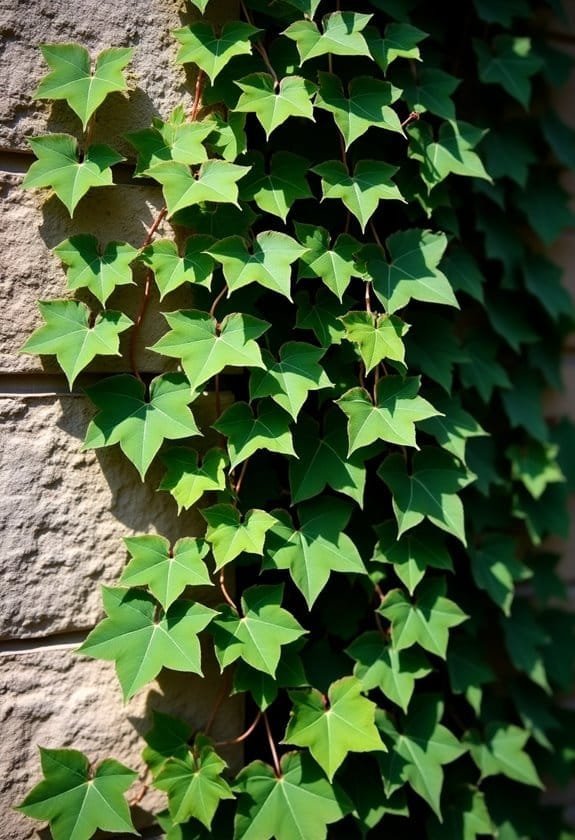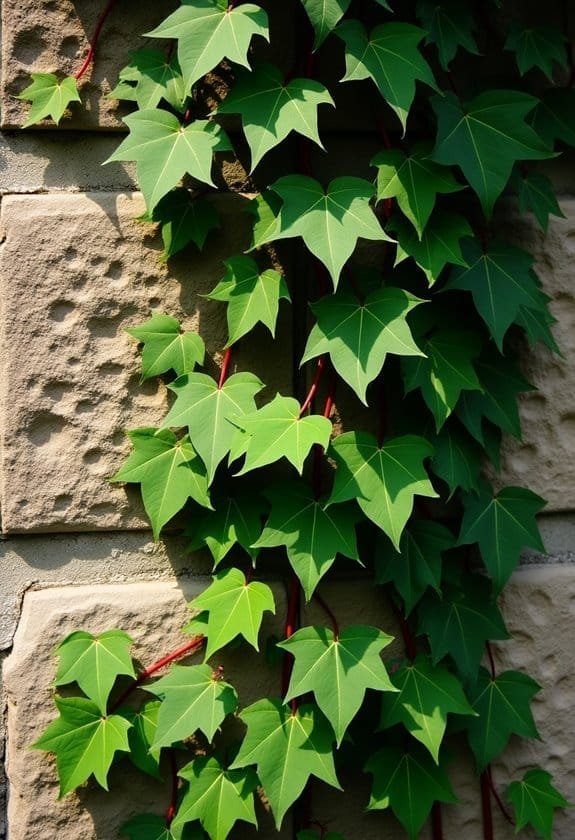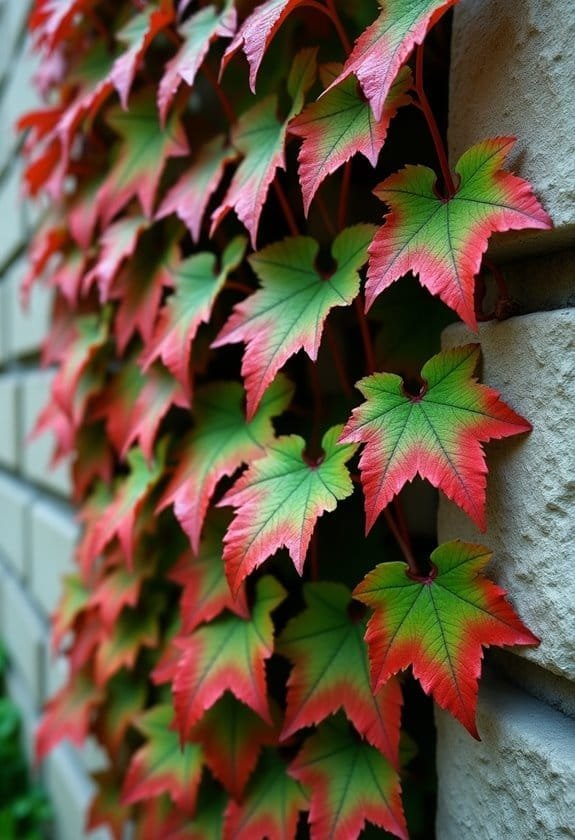Boston Ivy (Parthenocissus tricuspidata) is a robust climbing vine that can reach heights of 30-60 feet, featuring distinctive three-pointed leaves that transform from summer green to autumn burgundy. Native to East Asia, it's equipped with specialized adhesive tendrils that allow it to scale walls without causing structural damage. The vine thrives in USDA zones 4-8, adapting to various light conditions from full sun to partial shade, while requiring minimal maintenance once established. Its ecological benefits include supporting pollinators with spring flowers and providing birds with dark berries, while its dense foliage creates natural insulation for buildings and offers countless possibilities for architectural enhancement.
Main Points
- Boston Ivy is a fast-growing climbing vine reaching 30-60 feet tall, using adhesive discs to climb walls without causing structural damage.
- The plant features three-pointed leaves that turn from green in summer to stunning burgundy-red colors in autumn.
- It thrives in full sun to partial shade, adapts to various soil types, and grows well in USDA zones 4-8.
- Small greenish-white flowers appear in spring, followed by blue-black berries that attract birds and support local wildlife.
- Regular pruning and well-draining soil are essential for healthy growth, while monitoring helps prevent fungal diseases and pest issues.
Introduction

Boston Ivy (Parthenocissus tricuspidata) stands as one of the most versatile and visually striking climbing vines in ornamental horticulture.
This remarkable species transforms buildings and structures with its vigorous growth pattern, reaching impressive heights of up to 50 feet while maintaining a manageable spread of 10 feet.
From its adaptable nature in varying light conditions to its stunning seasonal color changes, Boston Ivy exemplifies the perfect balance between aesthetic appeal and practical functionality in landscape design.
Common Name
A versatile climbing vine, Parthenocissus tricuspidata is widely known as Boston Ivy, Grape Ivy, Japanese Creeper, or Japanese Ivy. The plant's primary common name, Boston Ivy, originated from its extensive use throughout the northeastern United States, where it became particularly associated with prestigious academic institutions and the iconic Ivy League aesthetic.
In different cultures, this remarkable plant has earned distinctive names that reflect its characteristics and behavior. In Mandarin Chinese, it's called "páqiánghǔ," which aptly translates to "wall-climbing tiger," highlighting its aggressive climbing nature. The Japanese name "tsuta" (蔦) offers a more straightforward designation for this adaptable vine. These varied names demonstrate how different cultures have interpreted and classified this plant based on its most notable features.
The scientific community recognizes Parthenocissus tricuspidata through its taxonomic name, which combines Greek elements: "Parthenocissus" meaning "virgin vine," and "tricuspidata" referring to its characteristic three-lobed leaves.
This nomenclature provides insight into both the plant's growth habit and its distinctive foliage structure, making it instantly recognizable among horticulturists and botanists alike.
Scientific Name
The scientific designation for this beloved climbing vine is Parthenocissus tricuspidata, which reflects both its botanical lineage and distinctive physical characteristics. The name's etymology reveals fascinating insights into the plant's nature, with "Parthenocissus" originating from Greek roots meaning "virgin vine," while "tricuspidata" stems from Latin, referring to the characteristic three-pointed leaf structure.
This formal botanical classification places Boston Ivy firmly within the grape family, highlighting its relationship to other climbing vines that share similar characteristics. The nomenclature proves particularly apt, as it accurately describes the plant's most distinguishing features: its climbing habit and distinctive foliage pattern.
While the common name "Boston Ivy" might suggest American origins, the scientific name helps botanists and gardeners understand its true native range across East Asia, particularly in China, Japan, and Korea. Understanding the scientific name also aids in identifying this species among its close relatives, as Parthenocissus tricuspidata exhibits unique characteristics that set it apart, including its specialized adhesive tendrils and distinctive three-lobed leaves that transform into brilliant autumn colors.
Overview
Beyond its scientific classification, this remarkable climbing vine has earned its place as one of gardening's most versatile and cherished plants. Boston Ivy captivates gardeners and landscapers with its extraordinary ability to transform vertical spaces, reaching impressive heights of up to 50 feet while extending 10 feet wide.
This adaptable climber showcases nature's artistic prowess through its distinctive palmately lobed foliage, which undergoes a dramatic seasonal change. The leaves shift from vibrant summer greens to a spectacular autumn palette of burgundy, orange, and red hues.
Its innovative climbing mechanism, featuring specialized tendrils with adhesive discs, allows for seamless vertical ascension without causing structural damage.
The vine's resilience is evident in its broad growing range, thriving across USDA zones 4 through 8, while demonstrating remarkable versatility in various soil conditions.
During late spring, Boston Ivy produces subtle greenish-white blooms that develop into dark blue-black berries, creating an essential food source for local bird populations. This combination of aesthetic appeal and ecological benefit makes it an exceptional choice for both ornamental and wildlife-friendly gardening applications.
Key Features
Boston Ivy stands as a remarkable climbing vine, reaching impressive heights of up to 50 feet while spreading laterally to cover 10 feet in width.
Its distinctive palmately lobed leaves transform through the seasons, displaying lush green foliage in summer before erupting into spectacular burgundy and orange-red hues during autumn.
The plant's inconspicuous greenish-white blooms emerge in late spring to early summer, followed by clusters of dark blue-black berries that serve as a natural food source for local bird populations.
Growth Size
With its impressive climbing ability, Boston Ivy reaches heights of 30 to 60 feet and spreads 5 to 10 feet wide, making it an ideal choice for covering large vertical surfaces. This vigorous climber's growth size allows it to transform blank walls and architectural features into living tapestries of foliage, particularly when its leaves reach their full width of up to 8 inches.
The plant's remarkable vertical reach is achieved through specialized tendrils equipped with adhesive discs, which enable it to scale surfaces efficiently without requiring traditional support structures.
As the vine matures, it develops a dense, self-supporting network of stems and foliage that can completely envelop its growing space. The substantial growth size of Boston Ivy serves both aesthetic and practical purposes, as it can effectively insulate buildings and create natural privacy screens.
Its adaptability to various light conditions, from full sun to partial shade, guarantees consistent growth patterns regardless of placement, while its tolerance of different soil types allows it to maintain its impressive dimensions across diverse growing environments.
Appearance
The striking visual features of Boston Ivy make it a standout among climbing vines. Its distinctive ovate leaves, which can expand to an impressive 8 inches in width, showcase a remarkable transformation throughout the seasons, progressively shifting from vibrant green to rich burgundy and wine-red hues during autumn.
The plant's appearance is further enhanced by its unique structural elements, including specialized branched tendrils equipped with adhesive discs that enable seamless vertical climbing.
Small, pale yellowish-green flowers emerge in clustered formations during late spring, creating a subtle yet elegant contrast against the expansive foliage. These blooms later develop into dark bluish-black berries, often concealed beneath the dense leaf coverage.
A notable characteristic of Boston Ivy's appearance is the presence of stipules covering both leaves and stems, adding textural complexity to its overall aesthetic.
This architectural vine creates a living tapestry when allowed to spread across surfaces, transforming bare walls and fences into lush, green canvases that change their appearance dramatically with each passing season.
Flowering Season
Nature's subtle display unfolds during late spring to early summer as Boston Ivy produces its modest yet purposeful blooms. During this flowering season, clusters of greenish-white flowers emerge amidst the plant's prominent foliage, creating an understated botanical performance that serves a significant ecological function.
While these diminutive blossoms mightn't command immediate attention, their presence attracts essential pollinators, particularly bees, which contribute greatly to the plant's reproductive success. The flowers exhibit distinctive characteristics, including short stamens and a superior ovary topped with a capitate stigma, facilitating efficient pollination mechanisms during their brief flowering period.
As summer progresses, these inconspicuous blooms transform into small, dark blue-black berries, often concealed within the dense canopy of leaves.
Though the greenish flowers may lack the dramatic appeal of showier garden specimens, their ecological importance can't be understated, as they maintain crucial relationships with local pollinator populations and contribute to the plant's successful reproduction cycle.
Growing Requirements

Boston Ivy flourishes in environments offering full sun to partial shade, requiring at least four hours of direct sunlight daily for ideal growth and autumn coloration.
Its adaptability extends to various soil compositions, though it demonstrates particular vigor in well-draining, loamy substrates with moderate moisture retention capabilities.
The plant's remarkable cold hardiness allows it to thrive in temperatures as low as 15°F, making it an excellent choice for gardeners across USDA zones 4 through 8 who seek a resilient climbing vine.
Light
Sunlight plays an essential role in Boston Ivy's development, with the vine thriving best in locations that receive at least 6 hours of direct sun daily. While this adaptable climber can tolerate partial shade conditions of 4-6 hours, full sun exposure promotes ideal growth and guarantees the plant's signature characteristics flourish.
The vine's relationship with light directly influences its seasonal display, particularly during autumn transformation. When positioned in full sun locations, Boston Ivy rewards gardeners with a spectacular fall color show, featuring intense crimson and burgundy hues that create striking vertical displays.
Although the plant demonstrates remarkable adaptability by growing in full shade, such conditions often result in less vigorous growth patterns and muted fall coloration.
Light exposure considerably impacts the vine's overall health and climbing capabilities. Insufficient sunlight can lead to elongated, weak stems as the plant stretches toward available light sources, compromising both its structural integrity and ornamental value.
Consequently, while Boston Ivy's versatility allows it to survive in various light conditions, ideal placement in well-lit areas guarantees the most robust growth and vibrant seasonal displays.
Soil
In relation to growing requirements, well-drained loamy soil provides the ideal foundation for Boston Ivy's robust growth and establishment.
This adaptable vine demonstrates remarkable versatility in its soil preferences, flourishing in conditions ranging from average garden soil to somewhat challenging growing environments.
The plant's tolerance for varying soil pH levels makes it particularly accommodating, as it can thrive in both slightly acidic and neutral conditions without showing signs of nutrient deficiency.
While proper drainage remains essential for preventing root rot and other moisture-related issues, Boston Ivy exhibits impressive resilience once established.
Young plants benefit from consistent moisture levels during their initial growing seasons, requiring supplemental watering during dry spells to develop strong root systems.
However, mature specimens showcase notable drought tolerance, making them excellent choices for low-maintenance landscapes.
The vine's ability to adapt to different soil compositions, from sandy loam to heavier clay-based mixtures, further enhances its appeal as a versatile climbing plant.
This adaptability, combined with its minimal soil preparation requirements, makes Boston Ivy an excellent choice for both novice and experienced gardeners.
Water
While newly planted specimens require consistent moisture to establish strong roots, Boston Ivy's water needs decrease considerably once the plant matures. During the initial growth phase, regular watering helps develop a robust root system, particularly during periods of limited rainfall or extended dry spells.
As Boston Ivy matures, its natural drought tolerance becomes increasingly evident, allowing gardeners to reduce watering frequency without compromising the plant's health. The key to successful water management lies in maintaining well-drained soil conditions, which prevent waterlogged roots and potential fungal issues.
Applying a 2-3 inch layer of organic mulch around young vines serves dual purposes: it helps retain essential moisture and provides insulation during colder months.
Although Boston Ivy demonstrates remarkable adaptability to various soil conditions, overwatering should be avoided as it can lead to root deterioration. Experienced gardeners recommend monitoring soil moisture levels by inserting a finger into the soil; if it feels dry at a depth of 2 inches, it's time to water thoroughly.
This approach guarantees ideal hydration while respecting the plant's natural resilience.
Temperature
Boston Ivy's remarkable temperature tolerance makes it a favorite choice for gardeners across diverse climate zones. This cold hardy vine demonstrates exceptional resilience, thriving in USDA zones 4 through 8 and withstanding temperatures as low as 15°F without significant damage to its structure.
The plant's adaptability extends beyond cold tolerance, as it flourishes in various heat conditions across zones 1-8. While Boston Ivy prefers full sun exposure, which enhances its striking fall color transformation to deep burgundy and vibrant orange hues, it can successfully adapt to partially shaded locations that receive between 4 to 6 hours of daily sunlight.
Young plants require additional protection during their first winter season, particularly in regions that experience severe temperature fluctuations. Applying a protective layer of mulch around the base helps insulate the root system during harsh winter months.
Once established, Boston Ivy's robust nature allows it to handle both temperature extremes with remarkable grace, making it an excellent choice for covering walls and structures in challenging climate conditions.
Pollinator Criteria
Boston Ivy's modest greenish-white flowers attract an array of beneficial pollinators, including bees and butterflies, during the late spring to early summer blooming period.
While the blossoms aren't visually striking, they serve as valuable nectar and pollen sources that support local pollinator populations throughout the growing season.
The plant's contribution to pollinator health extends beyond its flowers, as its dense foliage provides shelter and its dark berries sustain birds that play essential roles in maintaining the broader ecosystem's biodiversity.
Attracted Pollinators
Clusters of inconspicuous greenish-white flowers make this climbing vine an attractive destination for various pollinators, particularly bees and butterflies, during its late spring to early summer blooming period. The nectar-rich blooms serve as crucial food sources, supporting these essential insects during their most active seasons.
Boston Ivy's dense foliage creates protected microhabitats that offer safe havens for pollinators as they navigate between feeding sites. These natural corridors prove especially valuable in urban environments, where suitable habitats can be scarce.
The plant's climbing nature allows it to establish vertical gardens that effectively extend pollinator-friendly zones upward, maximizing available space for foraging activities.
The presence of this versatile vine enhances local biodiversity by providing sustained support for pollinator populations throughout their life cycles. When integrated into garden landscapes, Boston Ivy contributes to a network of resources that encourages consistent pollinator activity.
This relationship proves mutually beneficial, as the pollinators aid in the plant's reproduction while gaining essential sustenance from its flowers.
Pollination Method
The pollination process of Boston Ivy relies on both wind and insect activity, with the plant's small greenish-white flowers offering accessible nectar rewards to its visitors. During the late spring to early summer blooming period, these inconspicuous flowers cluster together, creating ideal conditions for successful pollination by various means.
Wind plays a significant role in the plant's reproductive strategy, carrying pollen grains between flowers across considerable distances. However, insect pollinators, particularly bees, contribute substantially to the pollination process by actively seeking out the flowers' nectar resources.
The plant's adaptation to different environmental conditions has resulted in a dual pollination approach that maximizes reproductive success in various settings. When fertilization occurs, the flowers develop into dark bluish-black berries, which attract birds and further enhance the plant's ecological network.
This multi-layered pollination strategy demonstrates Boston Ivy's evolutionary sophistication, as it's managed to develop mechanisms that guarantee successful reproduction through both abiotic and biotic means. The plant's ability to attract diverse pollinators particularly benefits urban environments, where pollinator populations may be limited.
Care & Maintenance

Boston Ivy's successful cultivation begins with proper planting in well-draining soil and careful attention to early watering schedules during establishment.
While the vine maintains remarkable self-sufficiency once established, it benefits from annual winter pruning to manage its growth pattern and occasional monitoring for potential pest issues, though these are quite rare.
Gardeners often pair Boston Ivy with shade-tolerant perennials like hostas or ferns beneath its canopy, creating an appealing layered effect in the landscape while maximizing space utilization.
Planting Tips
When planting Boston Ivy, successful cultivation begins with selecting the right location and soil conditions. This versatile vine thrives in well-drained, loamy soil that maintains consistent moisture without becoming waterlogged, and it adapts well to various light conditions from full sun to partial shade.
Given its robust growth pattern and adhesive tendrils, careful consideration must be given to the supporting structure's integrity and long-term maintenance requirements.
For ideal establishment, plant Boston Ivy in spring or early fall when temperatures are moderate, spacing vines approximately 5 to 10 feet apart to accommodate their spreading nature. Create planting holes twice the width of the root ball and at the same depth, ensuring the crown sits slightly above soil level to prevent rot.
While the vine demonstrates remarkable adaptability across USDA zones 4 through 8, it's crucial to incorporate organic matter into the planting site to enhance soil structure and nutrition. After planting, apply a 2-3 inch layer of mulch around the base, keeping it several inches away from the stem to prevent moisture-related issues and promote healthy root development.
Ongoing Care
Throughout its growing seasons, Boston Ivy demands relatively minimal attention, though consistent monitoring guarantees prime health and appearance. The cornerstone of ongoing care centers on annual pruning during late winter, which helps control the vine's vigorous growth while maintaining its desired architectural form.
For young plants, proper maintenance includes strategic mulching during winter months when temperatures approach 15°F, providing essential protection for developing root systems.
While established vines demonstrate impressive drought tolerance, newly planted specimens require consistent moisture, particularly during extended dry periods. The vine's resilient nature typically manifests in strong disease resistance, though vigilant monitoring for common pests like scale insects and leaf hoppers remains essential for peak growth.
Regular inspections for chlorosis and other foliar issues prove especially important during the plant's establishment phase, as early detection allows for swift intervention.
This thorough yet straightforward maintenance routine guarantees that Boston Ivy continues to serve its role as an elegant vertical accent, transforming walls and structures with its characteristic seasonal displays while requiring minimal intervention from gardeners.
Suggested Companions
Gardeners can enhance their Boston Ivy displays by selecting compatible companion plants that share similar cultural requirements. Clematis and climbing roses prove to be exceptional choices, as they create striking visual combinations while thriving under comparable growing conditions.
When planning companion plantings, it's vital to choose drought-tolerant species that can adapt to various soil types, guaranteeing a harmonious garden environment. These companion plants benefit from a protective layer of mulch around their base, which helps maintain consistent soil moisture and shields young Boston Ivy vines during winter months.
Maintaining these plant combinations requires attention to proper care techniques throughout the growing season. Pruning both Boston Ivy and its companions regularly to keep growth in check is significant, with late winter being the ideal time for this maintenance task.
Gardeners should also implement an integrated pest management approach, monitoring all plants for signs of disease or insect infestations. This vigilant oversight guarantees the entire planting scheme remains vigorous and healthy, contributing to a robust garden ecosystem where both Boston Ivy and its companion plants can flourish together.
Common Issues
Boston Ivy faces several notable health challenges, including fungal diseases like powdery mildew and leaf spot, which can compromise its ornamental value and vigor.
Common insect pests, particularly Japanese beetles and scale insects, may attack the foliage during growing seasons, requiring vigilant monitoring and timely intervention with appropriate controls.
While these issues rarely prove fatal to established plants, early detection and proper cultural practices, such as improving air circulation and maintaining ideal soil conditions, can effectively manage most problems before they become severe.
Pests/Diseases
While generally resilient against pests and diseases, Boston Ivy can face three primary challenges: fungal infections, insect infestations, and environmental stressors. The most common fungal issues include powdery mildew and various leaf spots, which can manifest during periods of high humidity or poor air circulation.
Among insect pests, Japanese beetles pose a notable threat to the foliage, creating characteristic skeletal patterns as they feed between leaf veins. Scale insects and leaf hoppers can also compromise the plant's vigor by extracting sap from stems and leaves, potentially leading to yellowing and stunted growth.
Environmental factors, particularly improper site selection, can exacerbate these pest and disease issues.
Regular monitoring serves as the cornerstone of effective pest management, allowing gardeners to identify and address problems before they become severe. When removing damaged vines, it's essential to sever them at the root to prevent regeneration, as Boston Ivy's tenacious nature can lead to persistent regrowth.
Maintaining proper spacing and ensuring adequate airflow can greatly reduce the likelihood of both fungal infections and insect infestations.
Solutions
Addressing common issues with Boston Ivy starts with proper prevention and maintenance. Regular monitoring of the plant's health enables early detection of problems like mildews and insect infestations, allowing for swift intervention before issues escalate.
Implementing proper cultural practices, such as ensuring adequate air circulation and avoiding overhead watering, can greatly reduce the likelihood of fungal diseases.
For established vines facing pest problems, targeted treatments can be applied based on the specific threat, whether it's scale insects, leaf hoppers, or Japanese beetles.
When considering removal, it's crucial to understand that Boston Ivy's tenacious nature requires a methodical approach. The most effective strategy involves cutting the vine at its base and carefully removing it from surfaces, followed by thorough root elimination to prevent regeneration.
During winter months, protecting young vines with a layer of mulch around the base helps shield them from harsh conditions and promotes robust spring growth. This preventive measure, combined with proper site selection and regular maintenance, creates ideal conditions for Boston Ivy's long-term health and vigor.
Summary

The versatile Parthenocissus tricuspidata, commonly known as Boston Ivy, stands out as a robust climbing vine that perfectly suits both practical and aesthetic gardening needs.
As a vigorous climber that can reach heights of 30-60 feet while spreading 5-10 feet wide, it's particularly effective at transforming bare walls and structures into living tapestries of foliage, while helping reduce cooling costs through natural shading.
This remarkable plant demonstrates exceptional adaptability, flourishing in USDA zones 4-8 and accommodating various light conditions from full sun to partial shade.
Its sophisticated climbing mechanism, featuring specialized tendrils with adhesive discs, enables secure attachment to diverse surfaces without causing structural damage.
Throughout the growing season, Boston Ivy delivers a spectacular display, shifting from lush green summer foliage to stunning burgundy and orange-red autumn colors.
The plant's environmental benefits extend beyond its aesthetic appeal, as its dark blue-black berries provide sustenance for wildlife, while its dense growth pattern makes it an excellent choice for erosion control and ground coverage in challenging landscapes.


